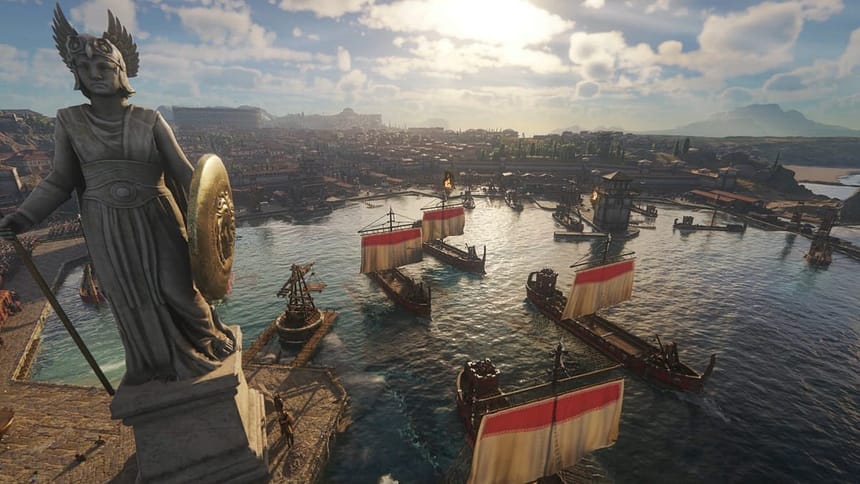Over three decades, the Anno series has plunged gamers into deep real-time strategy experiences set within some of the most massive empires that humans have ever built. From the Renaissance to the Industrial Revolution, Anno tasks players with balancing ravenous economic growth with conflicts of ideological revolution — and coming out the other side with a strong, unified state.
The next game in the series, Anno 117: Pax Romana, has the earliest historical setting for the Anno series to date, and it’s an incredibly ambitious shift (nearly as much as the brief stint in futuristic settings with Anno 2070 and Anno 2205). As the dates suggest, Anno 117 takes place during a time of immense economic and cultural prosperity in antiquity — and I got an early peek at how that looks during a three-hour hands-on virtual preview session moderated by an Ubisoft employee.
While Anno 117: Pax Romana is a game where you’ll still be focusing on your economy and fostering positive relations first and foremost, you’ll also need to consider building fortifications and training units for land and sea combat.
As the game is centered on growing your own Roman empire, you’ll have to choose which end to colonize first, either beginning in Latium (in modern-day western Italy, around Rome) as a Roman governor or expanding Celtic influence by starting in Albion (in modern-day England). My hands-on preview was limited to Roman gameplay, but I was able to see how much depth the Celts add to the game. Starting in Albion doesn’t just change the map geography and resource nodes you can build around, it changes the research trees, religions and construction projects you’re able to access as well.
Many contemporary 4X strategy games (it stands for explore, expand, exploit and exterminate) such as Sid Meier’s Civilization 7 and Age of Mythology: Retold focus heavily on outmaneuvering and destroying your opponents. In Anno 117, there isn’t really the same type of “win condition” — and there’s far less extermination to revel in overall.
The interwoven construction systems of Anno 117 are easy to pick up but difficult to master, especially if you want your empire to span multiple islands across the map. Here’s what I picked up about the game during my three-hour preview.
Majestic mountains and flowing fields of wheat surround the first stone residences of my budding province.
When building a civilization, the devil is in the details
If you’re choosing to set a game in the golden age of Roman civilization, it definitely makes sense to focus on graphical fidelity — I’m sitting down here to engage with the beauty and culture of Pax Romana.
Anno 117 doesn’t disappoint in this regard. Toward the tail end of my hands-on preview, I frequently found myself straying away from my self-imposed objectives to simply watch my citizens barter in the marketplace or work away on the wheat or hemp farms that stretched across the countryside.
Each dwelling you build adds three new citizens to your island, and these nonplayable characters are fully simulated as they go about their day-to-day business.
My citizens are enriching their interior lives in the grammaticus, a cultural center for reading and learning.
I watched the plebeians master their crafts, making silks and baking bread before they retired to cultural centers to find an education. The lower class libertini mined ore, chopped wood and delivered goods on handcarts, creating a constant stream of foot traffic that was mesmerizing to keep an eye on.
The complexity of these real-time interactions is a real treat. If too many workers gather at a warehouse with goods and raw materials, the roadways jam up and productivity drastically drops. It felt incredibly natural to manage these blockages and make necessary adjustments because I was already so involved with the little lives carrying on in the game.
Once you build something you feel truly proud of, Anno 117 has features that let you toggle the heads-up display off — I used this photo mode to capture some of my favorite pictures for this section of my preview. The images can’t capture the simple joy of watching fields of golden wheat swaying in the wind, but I think they convey the splendor of a budding city-state in Latium.
You can snap new structures diagonally onto roads and other buildings. But this feature is no substitute for poor city planning.
You might need an urban planning degree to run a well-oiled machine
If I could go back in time and restart my Anno 117 preview play session, I’d choose to take a beat before beginning construction on my starting island.
That’s no joke — every resource node, production center and citizen dwelling will affect how future supply chains are built, and that’s before factoring in the increasingly complex web of roads you’ll have to build to connect everything to the docks.
I shrugged and placed my first houses and farms randomly in the middle of the map, and it started causing problems for me hours later when I needed to build out unhygienic pigsties and hazardous kilns to broaden my civilization’s economic prospects.
There’s almost an overwhelming number of variables to juggle. Resources can only be extracted from certain nodes (and some fisheries and farms can only be built where the soil or water is suitably fertile for them), warehouses need to be located close enough for storage and production facilities will need speedy access to requisite materials.
I tried to separate my clay tile-producing kilns from the homes in my province’s city, but as my civilization expanded it became a greater fire hazard.
More complex goods require multiple resources to make, which means your supply chains will become even more complicated as ore, grain and animal products move further and further around your budding city.
As settlements become cities, problems emerge. Certain structures can spread disease and others are fire hazards, and you’ll need to invest in Pax Romana’s version of hospitals and firemen to mitigate these risks. I didn’t have to worry about invading forces in the demo — my Pax Romana was a true time of peace — but you’ll have to secure your borders in the full release, ensuring that there is enough military manpower spread around that your citizens are safe. It’s been some time since land combat was featured in an Anno game, but you can train warriors and scouts that patrol your land for different quest objectives.
The speed of your city’s growth and expansion is largely dependent on the caliber of citizens you’re drawing to your island: In order to upgrade your citizens, you must cater to their basic needs and their luxury wants by building them into the city-state’s supply chain.
While certain buildings provide debuffs to nearby citizens, other buildings will raise their happiness or fulfill certain needs.
This can be confusing to a new player — I was left momentarily scratching my head about being limited to construction of logging camps, wheat farms and basic food and clothing production — but the real construction possibilities open up once you begin diversifying your population with more worker types. I unlocked the plebeians in the latter half of my first hour with Anno 117, and that’s when the game truly picked up and more construction options became available.
Even so, I’d caution against rushing the citizen class upgrades. Expanding too quickly is a huge strain on your purse, and I found that I needed to spend a lot of denarii in order to establish a decent income.
This is one of the cases where slow and steady improvements to your supply lines are extremely important. I quickly learned the lesson that private equity seemingly hasn’t: Don’t sacrifice long-term growth on the altar of short-term profits. That’s a good way to get hosed down with a net negative denarii drain, which will slow your expansion indefinitely.
If you’re willing to take the time to do some very basic planning before clearing out trees and establishing your first builds, I expect players will find Anno 117 to be a very rewarding (if occasionally confusing) city builder spanning a rich territorial tapestry of different island factions.
I didn’t personally get a chance to sail the seas, but I built my first boatyard — this will be an extremely important part of Anno 117’s core gameplay loop.
Hidden at the periphery: Trade routes, disputes and random events
During my three-hour play session, I was largely relegated to a single island, building out the basic necessities and cultural landmarks that serve to kickstart a burgeoning Roman province. Even still, I was able to get a glimpse at some of the game’s deeper systems — and there’s a lot going on in the wider world while the player is getting themselves situated.
There are many other nonplayable characters governing their own states on neighboring islands, and I would occasionally get notifications informing me of their achievements in research, development and trade.
These pop-ups created a sense of urgency — my civilization was not being built within a vacuum, and I couldn’t be sure if these other peoples had a tendency to build mutually beneficial relationships or if they stood only to conquer their nearby foes. I mostly enjoy building trade routes and forging alliances with others, but I would be lying if I said that these infrequent updates didn’t have me contemplating an investment in a bigger military presence.
I imagine that starting with the Romans in Latium or the Celts in Albion won’t just affect the nodes you can unlock in your research tree, but will change the way different neighbors interact with you as you make contact with them throughout the wider world.
Not every interaction with outsiders is a promise to paint the streets or oceans red — and outside of trade, there are other ways that NPC factions help you build a better future.
I chose Ceres as my patron goddess, since I was primarily building into agriculture.
Provinces that adopt the same faith as you cement the belief in your gods, and both societies will reap greater buffs as the religion spreads among a larger population. These boons can increase research speed, military might or economic production. A rising tide raises all ships, and spreading religious fervor benefits all governors who worship the same gods.
Players will exert influence on the wider world, but it will also exert an influence on their own city-state: The society they’ll build is only one piece of a much grander, ever-shifting puzzle.
On a more granular level, a player’s civilization will undergo random events and disputes that keep it in a state of perpetual motion. Their people are never at a standstill (unless one uses their omnipotent powers to literally pause time) and as such, they’ll have trade disagreements, spread rumors and even riot.
Some of these events are simple decisions: In a moment of economic turmoil, I took a bribe from a wealthy businessman, but ended up enraging workers throughout the city; another time, I chose a personal advisor who increased my passive income instead of one who would optimize the storage of my warehouses.
The buffs (or debuffs) that are attached to these choices are not insubstantial, and so it feels like your decisions really matter. They drive the future direction of your province.
Other events start up more involved questlines — when citizens live in fear of a nearby shipwreck that is said to be haunted, I’d have to train up a scouting party and send them into the depths to report on what was truly happening. These secondary objectives make your territories feel alive and engage the player outside of the usual city-building activities.
There’s a complex world hidden behind the curtain of Anno 117, but the game is approachable for new real-time strategy players, continuing the series’ usual throughline of placing an emphasis on solving conflict through economic and diplomatic means.
Combat is certainly present, but I was able to completely avoid it during my preview session, leading me to wonder how much fighting there will truly be for the more military-minded players. Either way, Anno 117: Pax Romana sold me on its premise — and I wanted to continue building my empire during this historically unprecedented time of peace.
Anno 117: Pax Romana is set to be released in 2025, but we don’t have an exact date as of yet. The game will be available on PC, PS5 and Xbox Series X and S.
Watch this: I Attended the Public Nintendo Switch 2 Experience





